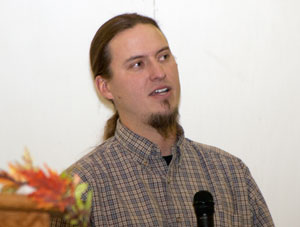Economic Model for Multiple Land Use
by Troy Smith for Angus Productions Inc.
MITCHELL, Neb. (Dec. 1, 2011) — During Range Beef Cow Symposium XXII in Mitchell, Neb., University of Wyoming agricultural economist John Ritten talked about the adoption, by government land management agencies of ecological state and transition models (STMs) for rangeland inventory and modeling. The purpose of STMs is to provide rangeland managers, including ranchers, with a tool for managing complex social-ecological systems.
Ritten said rangeland managers are concerned with the economic sustainability of ranching operations. Increased public awareness of the additional services (plant biodiversity, wildlife habitat, etc.) these diverse ecosystems provide means they are under pressure to manage for public benefits as well. However, Ritten said there are few tools providing information needed to understand the tradeoffs associated with managing for multiple use.
“STMs are used to assess current conditions in relation to known ecosystem dynamics, identify management objectives and appropriate monitoring indicators, and assess whether objectives are being met,” explained Ritten. “STMs represent a key tool in the process of adaptive management because they provide a clear representation of the best current knowledge about how a given ecosystem responds different management and environmental factors.”

John RittenAs an example, Ritten described a decision-making model for a “typical” ranch in northern Colorado, incorporating field data and local knowledge from ranches in the region. The STM showed how the landscape changes, over time, in response to management, weather events and other impacts, as well as economic outcomes. Evaluation of response can then be used to make future management decisions, including those related to stocking rates and brush control, to tailor management for optimum use of rangeland.
Ritten said the results reinforce the concept of managing for long-term productivity, rather than short-term profits. Results also suggest optimal livestock production can successfully coexist with some other ecosystem services, but at the same time may not be well-aligned with other additional services. Ranchers may not be able to provide all other services, in addition to livestock production, and must choose.
“It shows you can’t have everything,” said Ritten. “There are tradeoffs.”
To view the PowerPoint that accompanied Ritten's presentation, click here.
The biennial Range Beef Cow Symposium was hosted Nov. 29-Dec. 1 at the Mitchell Events Center, Mitchell, Neb., by the cooperative extension and animal science departments of the University of Nebraska-Lincoln, South Dakota State University, Colorado State University and the University of Wyoming. Comprehensive coverage of the event is provided online at www.rangebeefcow.com, an event coverage site provided by Angus Productions Inc. (API), publisher of the Angus Journal and the Angus Beef Bulletin.
Editor’s Note: API's coverage of the event is made available for distribution to all media via an agreement with the Range Beef Cow Symposium Committee and API. Headquartered in Saint Joseph, Mo., API publishes the Angus Journal, the Angus Beef Bulletin, the Angus Beef Bulletin EXTRA, and the Angus e-List, as well as providing online coverage of events and topics pertinent to cattlemen through the API Virtual Library. For questions about this site, or to notifiy us of broken links, click here.

